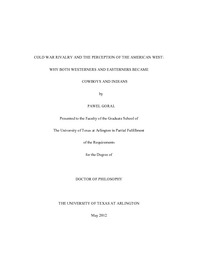
ATTENTION: The works hosted here are being migrated to a new repository that will consolidate resources, improve discoverability, and better show UTA's research impact on the global community. We will update authors as the migration progresses. Please see MavMatrix for more information.
Show simple item record
| dc.contributor.author | Goral, Pawel | |
| dc.date.accessioned | 2016-01-28T18:19:30Z | |
| dc.date.available | 2016-01-28T18:19:30Z | |
| dc.date.submitted | May 2012 | |
| dc.identifier.other | DISS-11607 | |
| dc.identifier.uri | http://hdl.handle.net/10106/25565 | |
| dc.description.abstract | As the competing ideologies of the Cold War became crucial components of the rivalry, cultural influences gained symbolic power as well. American popular culture had such a tremendous impact upon Europe that the states of the communist bloc denounced it as cultural imperialism. The Western, combined with cultural power and cultural beliefs, analyzed here as a major cold war weapon of influence, contributes to an understanding of transatlantic intercultural transfer, best illustrated by the production of German Westerns between 1962 and 1983.
This dissertation demonstrates how the adversaries of the Cold War endeavored to create two distinct and unique German identities. This proved to be a complicated process whereby two newly created states chose myths from another country located in another hemisphere to come to terms with their own dark past and articulate a vision for a better future. In their endeavor to claim legitimacy, the German cinematic representation of the American West became an important cultural weapon of mass dissemination during the Cold War.
This project examines the following juxtapositions: American vis-à-vis German and East German vis-à-vis West German. The primary questions the study answers are: how do East German Westerns compare with both West German and American Westerns and what do they teach about the nature of intercultural transfer between both sides of the Iron Curtain during the Cold War? How does the portrayal of the United States in German Westerns modify historians' understanding of the role and image of the United States in the Cold War? Ultimately, this dissertation determines whether both East and West Germany produced Westerns because they were influenced by American cultural images and whether through the use of this very American genre their own productions acquired special meaning. In this case, it is the creation of an American identity, based on the American myth of the frontier, by non-Americans for non-Americans during an ideological conflict that spanned the intersection of various cultural realms. | |
| dc.description.sponsorship | Adam, Thomas | |
| dc.language.iso | en | |
| dc.publisher | History | |
| dc.title | Cold War rivalry and the perception of the American West: Why both westerners and easterners became cowboys and Indians | |
| dc.type | Ph.D. | |
| dc.contributor.committeeChair | Goldberg, Joyce S. | |
| dc.degree.department | History | |
| dc.degree.discipline | History | |
| dc.degree.grantor | University of Texas at Arlington | |
| dc.degree.level | doctoral | |
| dc.degree.name | Ph.D. | |
Files in this item
- Name:
- out.pdf
- Size:
- 3.692Mb
- Format:
- PDF
This item appears in the following Collection(s)
Show simple item record


